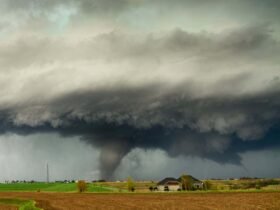Earth’s space junk may be wreaking havoc on the stratosphere.
The rapid surge in satellite megaconstellations is connecting much of the world to broadband internet. But each year, hundreds of those satellites die, burning up in the atmosphere as they fall. And each year, more and more satellites are being launched to replace them.
The dying satellites, it turns out, don’t just wink out into the ether. Each one leaves a bit of itself behind.
The satellites’ fiery death throes, along with a steep rise in the number of rocket launches, are adding a glut of ozone-destroying and climate-altering pollutants to the stratosphere, researchers say. What that means for the planet’s atmospheric chemistry — including its ultraviolet light–shielding ozone layer — isn’t yet clear. But scientists are racing to find out.
“The launches are growing so quickly,” says Daniel Murphy, an atmospheric scientist at the National Oceanographic and Atmospheric Administration’s Chemical Sciences Laboratory in Boulder, Colo. “In the last couple of years, there have been roughly 500 re-entry events per year, and people are talking about 10,000 in the not-too-distant future. That’s about one an hour. So we’d like to understand the implications as soon as possible.”
Commercial constellations
Currently, there are about 10,000 active satellites in orbit around the planet. Two-thirds belong to Starlink, SpaceX’s megaconstellation (SN: 3/3/23). Another 630 are part of London-based Eutelsat OneWeb. And other internet projects intend to catch up quickly: In August, China launched the first 18 satellites for its Qianfan, or “Thousand Sails,” constellation, ultimately planned to comprise at least 12,000 satellites. Another planned Chinese project, known as Honghu-3, aims to link up to 10,000 satellites.
By some estimates, there may be as many as 100,000 satellites in near-Earth orbit by the 2030s, with possibly half a million circling the planet in the decades to follow.
These internet satellites are disposable by design: They may serve a few years in a constellation network before being “decommissioned” — sunk into a lower orbit until they ultimately fall to a fiery death through the sky. Each disintegrating satellite injects metals into the atmosphere, many of which are metals either not typically found there or ones that are being added in much greater abundances than are naturally introduced.
Telltale traces
The first step to understanding the scope of the problem is identifying the traces of burnt-up spacecraft, and whether those traces are comparable or even detectable against the background of natural meteorite debris from space.
That research is just getting started.
In 2023, Murphy and colleagues presented definitive evidence that metals specifically from spacecraft, rather than just natural sources, were indeed aloft in the stratosphere, the layer of atmosphere extending from six to 20 kilometers above Earth’s surface. Stratospheric particles of sulfuric acid in the upper atmosphere over the Arctic turned out to contain over 20 different elements consistent with spacecraft production. Those elements, Murphy says, included niobium and hafnium, both refined from mineral ores for use in heat-resistant alloys. Other metals such as lithium, lead, aluminum and copper — which can be present naturally — were found in abundances far exceeding what might organically waft in via cosmic dust.
And the evidence of erstwhile spacecraft is accumulating. From 2020 to 2022, scientists tracked a stratospheric rise in pollutants, corresponding to the rapid rise in satellite launches.

Emissions of aluminum and nitrogen oxides from satellite reentries nearly doubled from 3.3 billion grams in 2020 to 5.6 billion grams in 2022, atmospheric chemist Connor Barker of University College London and colleagues reported in April in Vienna at a meeting of the European Geophysical Union. By 2022, re-entry inputs of nitrogen oxides, they found, were equivalent to about a third of the natural inputs of the gases from meteors. And aluminum oxide inputs were surpassing natural inputs by a factor of seven.
Pollutant emissions from rocket launches are also on the rise, Barker and his colleagues found. Propellant consumption nearly doubled from 2020 to 2022, from 38 billion grams to 67 billion grams. Those launch emissions can include pollutants such as black carbon, nitrogen oxides, carbon monoxide, aluminum oxide and a variety of chlorine gases.
Chemical impacts
The spacecraft debris could have a variety of ripple effects through the chemistry of the stratosphere.
It could spell bad news for the ozone layer in particular. Aluminum oxide, for example, is a by-product of the oxidation during re-entry of aluminum-based spacecraft components, says José Ferreira, an aerospace engineer at the University of Southern California in Los Angeles. “And we know that aluminum oxides are catalysts for ozone depletion.”
This new threat to the ozone layer is particularly frustrating in the wake of the success of the Montreal Protocol, a 1987 agreement to ban the production and emissions of known ozone-destroying chemicals (SN: 2/10/21). By 2016, the annual hole in the ozone layer that forms over Antarctica was already showing signs of healing, on track to completely close up within about 50 years (SN: 12/14/16).
There are myriad other ways that spacecraft pollutants might tinker with the atmosphere’s complex chemical brew, Murphy says. Soot emitted from rocket engines absorbs solar energy, which can warm the atmosphere. Copper and other metals released during the incineration of spacecraft wiring and alloys are known to be powerful catalysts for chemical reactions in the atmosphere. Among other things, those metals could promote the creation of the tiny particles that act as the seeds of clouds.
There’s not much direct information on which of these reactions might already be happening. The data that do exist are destined for computer simulations that track the life cycle of these pollutants and their interactions in the atmosphere. Murpyh’s team is planning more flights in 2025 to continue tracking the growing inventory of spacecraft debris.
Ferreira, meanwhile, is considering ways to incorporate an environmental impact assessment into the design phase of space missions. “If we identify upfront that a component or a chemical will be detrimental to the atmosphere, we can either find an alternative or invest in research into more environmentally friendly options,” Ferreira says.
For now, the question of impacts from the scattered stuff of satellites is so new that there hasn’t yet been much funding to address it, Murphy says. But, he adds, “I think it needs to happen fast. It’d be really good to know these things before these satellites are built and launched.”
Source link













Leave a Reply